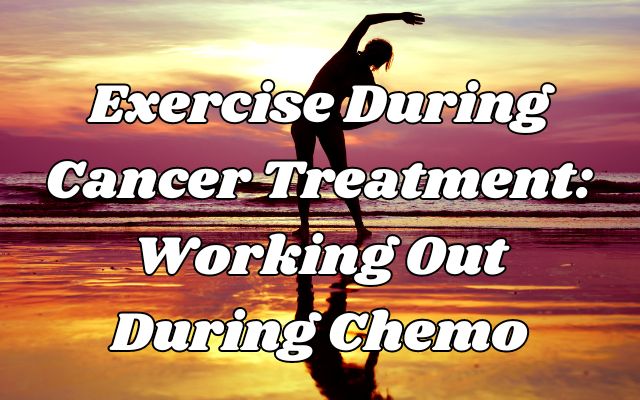Exercise During Cancer Treatment: Working Out During Chemo

Engaging in regular, gentle exercise during cancer treatment can help improve the overall well-being and resilience of patients. Exercise is an essential component of cancer treatment. Regular exercise during cancer treatment can significantly enhance physical and mental health during any stage of treatment, according to a growing body of evidence.
Even if you were not physically active prior to your cancer diagnosis, a chemo and exercise programme tailored to your specific needs can assist you in getting moving safely and effectively.
Doctors used to advise cancer patients not to engage in strenuous physical activity while undergoing treatment.
While it’s crucial to avoid motions that cause pain or other problems, new evidence reveals that exercise can be both safe and beneficial during cancer treatment.
Too much rest, in fact, can lead to a loss of muscular strength, body function, and range of motion.
A good working out during chemo can improve your quality of life and make you feel better.
Why Exercise During Cancer Treatment Is Important?
Doctors aren’t sure exactly how physical activity affects cancer recovery. Regular activity, on the other hand, can aid in a variety of ways before and after cancer therapy.
Working out during chemo can help you:
- Pain and weariness will be relieved.
- Assist in keeping your body in good working order.
- It will make you feel less nauseated.
- Improve your balance to reduce the risk of falls and broken bones.
- Reduce your risk of osteoporosis, which can help keep your bones strong.
- Maintain a healthy weight, which can help prevent cancer from returning.
- Reduce your risk of heart disease.
- Assist you in retaining more muscle
- Improve blood flow to your legs to reduce the risk of blood clots and reduce swelling.
- Allow you to be more self-sufficient and maintain your self-esteem
- Reduce your risk of anxiety and sadness.
Some experts believe that exercise for cancer patients can help their immune system fight tumors while you’re undergoing cancer therapy.
Before You Exercise During Cancer Treatment
Before beginning an exercise regimen during or after cancer treatment or working out during chemo, always consult your doctor. While exercise has been shown to be safe during many types of cancer therapy, your capacity to exercise and the types of exercises for cancer patients they can do are dependent on the following factors:
- The sort of cancer you’ve been diagnosed with
- Treatments that are being employed
- You’re having some unpleasant side effects.
- Your fitness level
- Your other medical issues
If you were physically active prior to treatment, you may not be able to continue with your previous working out during chemo schedule. It will take time to get back to your pre-cancer fitness level after treatment.
Request a referral from your doctor for a certified cancer exercise specialist who can create the best schedule for working out during chemo for your specific needs.
You might be able to stick to the plan on your own. Alternatively, you may need to work with an exercise specialist for a period of time.
Other Things To Know Before You Begin
- Start each workout slowly and gradually increase the intensity as you feel ready.
- If you’re not sure if you’re in good enough shape to exercise, start with a few minutes and quit if you begin to feel worse.
- Take a break if you’re feeling particularly weary throughout a workout.
- Make sure you drink at least 8 cups of water per day to stay hydrated during your workout.
- You may require more water if you workout in the heat.
- You should also make certain that your training location is secure.
- Look for a location with flat ground and nothing to trip over.
- If you’ve been exposed to radiation, you should avoid swimming pool activities because germs in pools might cause infection. The chlorine is a poisonous substance.
What Should Be In Your Exercise Program
A safe and successful fitness programme before and after cancer treatment requires a variety of different sorts of workouts. In general, a comprehensive programme of exercising during cancer treatment should include the following:
Breathing Exercises
Shortness of breath or trouble breathing may occur in cancer patients. This may prevent individuals from engaging in physical activity.
Breathing exercises boost your endurance by moving air in and out of your lungs. Exercise during chemo can also help you relax if you’re stressed or anxious, which causes your muscles to stiffen.
Stretching
Stretching on a daily basis might help you gain flexibility and improve your posture. It can help your body repair itself by increasing the flow of blood and oxygen to the muscles.
If you’ve been inactive while recovering from cancer treatments, stretching can be quite beneficial. Radiation therapy, for example, can restrict your strength and flexibility and induce your muscles to stiffen. Stretching can assist to decrease scar tissue after surgery.
Balance Exercises
Cancer and its treatment might cause a loss of balance as a side effect. Balance exercises can assist you in regaining the function and mobility you require to safely return to your everyday activities. Maintaining good balance can also help you avoid injuries like falls.
Aerobic Exercise
This is a sort of exercise that elevates your heart rate and is also known as cardio. It can help you feel less exhausted during and after treatment by strengthening your heart and lungs.
Walking is a simple and effective approach to get some cardio exercise. For example, your doctor may recommend walking 40 to 50 minutes at a moderate pace three to four times a week.
Strength Training During Chemotherapy
When a person is less active throughout cancer treatment and rehabilitation, muscle loss is common. Muscle weakness is a side effect of some medications.
Strength training during chemotherapy, often known as resistance training, is a type of exercise that helps you maintain and create strong muscles. Increased muscle mass can aid in improving balance, reducing tiredness, and making daily tasks easier.
Read Also: What Is Cervical Cancer: Cancer Test Wait Putting , A Report
It may also aid in the treatment of osteoporosis, a bone thinning condition caused by some cancer treatments.
Exercising Safely During Treatment
If you are experiencing side effects from your cancer or its treatment, it is critical to exercise with caution. Depending on your unique side effects, you may need to alter your workout routine.
If your treatment is damaging the nerves in your hand, for example, weight machines may be a better option than hand weights.
If your treatment has resulted in bone loss, you should avoid neck-stretching exercises that increase your risk of falling.
Other techniques to make sure you get the most out of your training regimen while being safe are listed below.
Progress Slowly
Even if you were physically active prior to your therapy, gradually increase your activity level. This can help you avoid harm and avoid becoming frustrated.
Exercise In A Safe Environment
If your immune system has been compromised by therapy, stay away from huge gyms where germs can readily spread.
Listen To Your Body
If your energy level is low, reduce the length or intensity of your workout until you feel better.
Stay Hydrated
To minimize dehydration, drink plenty of water during your workouts.
Eat A Nutritious Diet
The appropriate nutrients, particularly those high in protein, aid in the recovery of your body after exercise. An oncology dietitian can assist you in creating a diet plan.
See Your Doctor Regularly
During treatment, your health may change. Make sure your doctor checks crucial health markers like your blood count to see if you can exercise safely.
Conclusion
Exercise may be prescribed as part of a cancer recovery programme. However, there is a distinction to be made between exercise and cancer rehabilitation.
Cancer rehabilitation is a comprehensive therapy programme that assists a person in maintaining their capacity to perform while undergoing cancer treatment and thereafter.
Exercises are therapies utilized in a cancer rehabilitation programme to address specific health and movement difficulties.
Disclaimer
Articles with medical material must be used solely for the purpose of providing general information. Such materials should not be used for (self-) diagnosis or treatment of specific illnesses or medical conditions. They cannot, for example, replace a licensed physician’s or pharmacist’s examination, advice, or treatment. The articles will not be used to respond to any specific questions.
Q- Is it permissible to exercise while undergoing chemotherapy?
A- Exercising during chemotherapy can help alleviate side effects like exhaustion and nausea, as well as strengthen your immune system. Chemotherapy side effects might make exercise difficult, but do your best to be as active as you can. Walking is a fantastic place to begin once more.
Q- What type of exercise is beneficial for cancer patients?
A- Cancer sufferers – and everyone else – can benefit from the following sorts of exercise:
- Stretching is a type of flexibility exercise.
- Brisk walking, jogging, and swimming are examples of aerobic exercise.
- Resistance training (lifting weights or isometric exercises) is a type of muscle-building exercise.
Q- Is it possible for exercise to make cancer worse?
A- According to a new study, exercising is a good strategy to avoid cancer. Adrenalin, which is released during intense training, inhibits metastases from spreading and developing elsewhere in the body. This not only prevents cancer from spreading but also makes it easier to treat.
Q- Is it possible to decrease tumors through exercise?
A- We all know that exercise is beneficial to our health, but moving your body can also aid in the treatment of some severe diseases. Exercise not only lowers the growth of solid tumors, but it also speeds up recovery in patients with critical illnesses, according to two recent studies.
Q- Is it possible to burn cancer cells through exercise?
A- “Exercise influences the creation of a number of chemicals and metabolites that activate cancer-fighting immune cells and hence suppress cancer growth,” says the study.



